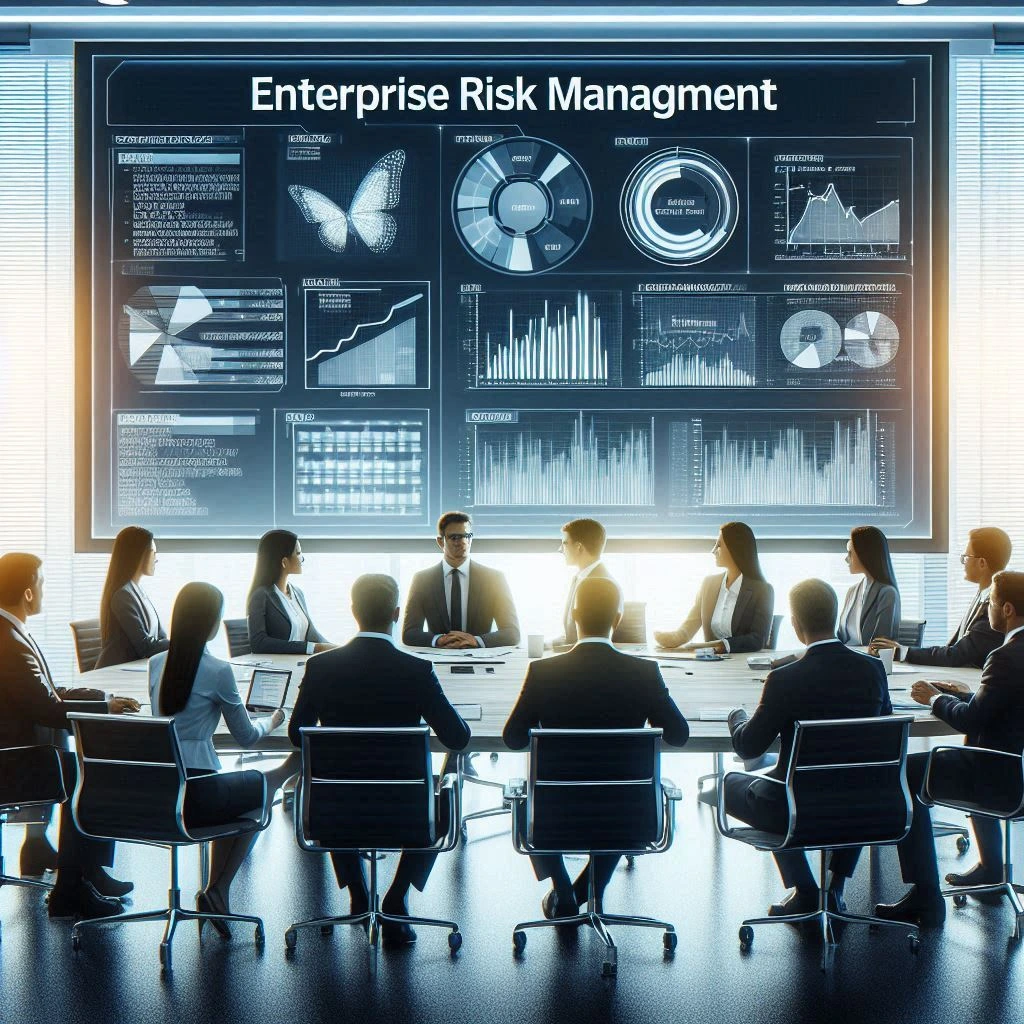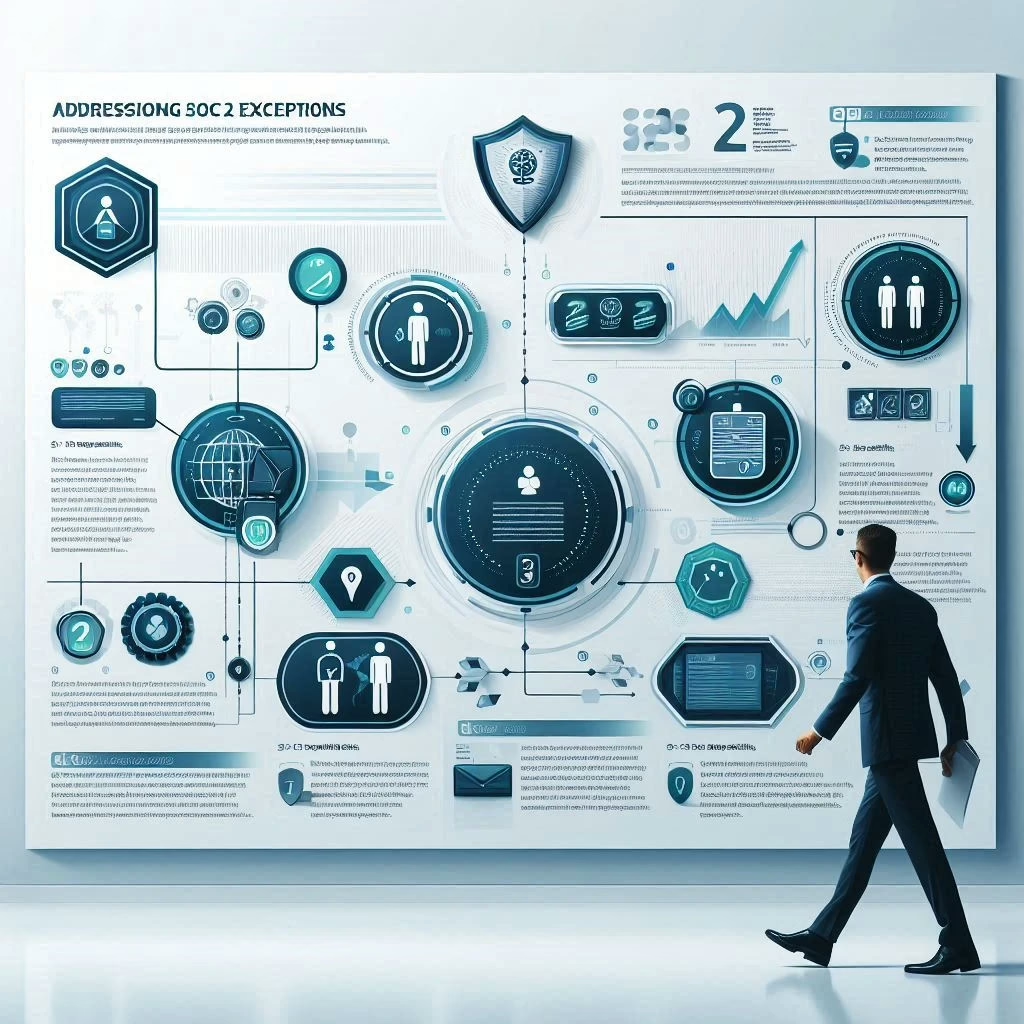Introduction to Enterprise Risk Management (ERM)
Enterprise Risk Management (ERM) is a comprehensive and systematic approach to identifying, assessing, and managing risks that could potentially impact an organization’s objectives. It encompasses a wide range of risks, including financial, operational, strategic, and compliance risks, and aims to create a risk-aware culture within the organization.
- Definition of Enterprise Risk Management (ERM): ERM is defined as a methodology that takes a top-down approach to risk management, focusing on the identification and assessment of risks, as well as the development of strategies to mitigate them. This framework not only seeks to minimize potential losses but also aims to maximize opportunities for success by aligning risk management with the organization’s overall strategy and objectives [6][11].
- Overview of the Evolution of ERM in Organizations: The concept of ERM has evolved significantly over the years. Initially, risk management was often siloed within specific departments, focusing primarily on compliance and financial risks. However, as organizations faced increasingly complex and interconnected risks, the need for a more integrated approach became apparent. Today, ERM is recognized as a critical component of organizational governance, with frameworks being developed to guide its implementation across all levels of the organization [1][3]. This evolution reflects a shift towards a holistic view of risk, where all potential risks are considered in the decision-making process.
- Importance of ERM in the Context of Internal Audit: The role of internal audit in the ERM framework is vital. Internal auditors are responsible for evaluating the effectiveness of the ERM processes and ensuring that significant risks are appropriately identified and assessed on an ongoing basis. By providing independent assurance and insights into risk management practices, internal auditors help organizations enhance their risk management capabilities and ensure that risks are managed in alignment with the organization’s objectives [12][14]. Furthermore, a well-implemented ERM framework can facilitate better communication and collaboration between internal audit and other departments, fostering a culture of risk awareness and proactive risk management [15].
The Significance of ERM in Internal Audit
Enterprise Risk Management (ERM) plays a pivotal role in shaping the internal audit landscape, providing a structured approach that enhances the effectiveness and efficiency of audit processes. Understanding the significance of ERM in internal audit is essential for professionals in the field, as it not only guides audit objectives but also strengthens organizational governance. Here are some key points to consider:
How ERM Frameworks Guide Internal Audit Objectives
- Alignment with Organizational Goals: ERM frameworks help internal auditors align their objectives with the broader goals of the organization. By identifying and assessing risks that could impede the achievement of these goals, internal audits can focus on areas that matter most to the organization’s success [1][12].
- Risk-Based Approach: Internal audits are increasingly adopting a risk-based approach, which is a core principle of ERM. This means that audits are prioritized based on the level of risk associated with different processes and functions, ensuring that resources are allocated effectively to areas of highest concern [4][11].
- Continuous Improvement: ERM frameworks promote a culture of continuous improvement within organizations. Internal auditors can leverage insights from ERM processes to refine their audit methodologies and enhance the overall risk management practices [5][10].
The Relationship Between ERM and Organizational Governance
- Strengthening Governance Structures: ERM provides a comprehensive framework that supports organizational governance by establishing clear roles and responsibilities for risk management. This clarity enhances accountability and ensures that risk considerations are integrated into decision-making processes at all levels [2][15].
- Facilitating Communication: Effective ERM fosters better communication between internal audit and other governance bodies, such as the board of directors. This collaboration is crucial for ensuring that risk management strategies are understood and supported throughout the organization [11][15].
- Enhancing Transparency: By embedding risk management into governance frameworks, ERM enhances transparency regarding risk exposure and management strategies. This transparency is vital for building trust among stakeholders and ensuring informed decision-making [3][12].
Case Studies Illustrating the Impact of ERM on Internal Audits
- Case Study 1: A Financial Institution: A major bank implemented an ERM framework that significantly improved its internal audit processes. By focusing on high-risk areas identified through the ERM assessment, the internal audit team was able to uncover critical vulnerabilities that had previously gone unnoticed, leading to enhanced compliance and risk mitigation strategies [10][12].
- Case Study 2: A Manufacturing Company: A manufacturing firm adopted an ERM approach that integrated risk management into its operational audits. This integration allowed the internal audit team to identify operational inefficiencies and compliance risks, resulting in a more robust risk management culture and improved operational performance [11][14].
- Case Study 3: A Healthcare Organization: A healthcare provider utilized ERM to streamline its internal audit processes, focusing on patient safety and regulatory compliance. The insights gained from the ERM framework enabled the internal audit team to prioritize audits that directly impacted patient care, ultimately leading to improved outcomes and reduced risks [12][13].
Key Components of ERM
For internal auditors and risk management professionals, understanding the key components of ERM is crucial for effective risk oversight and governance. Below, we break down the essential elements that constitute an effective ERM framework.
1. Risk Identification: Techniques and Tools
Risk identification is the foundational step in the ERM process. It involves recognizing both internal and external risks that could impact the organization. Various techniques and tools can be employed for this purpose, including:
- Brainstorming Sessions: Engaging teams across different departments to gather diverse perspectives on potential risks.
- SWOT Analysis: Evaluating strengths, weaknesses, opportunities, and threats to identify risks associated with strategic objectives.
- Risk Checklists: Utilizing predefined lists to ensure that common risks are not overlooked.
- Scenario Analysis: Exploring hypothetical situations to uncover potential risks and their implications.
These methods help create a comprehensive risk profile that informs subsequent steps in the ERM process [3][8].
2. Risk Assessment: Qualitative vs. Quantitative Approaches
Once risks are identified, the next step is risk assessment, which evaluates the likelihood and potential impact of these risks. This can be approached in two primary ways:
- Qualitative Assessment: This method involves subjective judgment to categorize risks based on their severity and likelihood. Techniques such as risk matrices can be used to visualize and prioritize risks.
- Quantitative Assessment: This approach relies on numerical data and statistical methods to measure risks. It often involves calculating potential financial impacts and probabilities, providing a more objective basis for decision-making.
Both approaches have their merits, and organizations may choose to use a combination of both to gain a holistic view of their risk landscape [8][9].
3. Risk Response Strategies: Mitigation, Acceptance, Transfer, and Avoidance
After assessing risks, organizations must decide how to respond. Common risk response strategies include:
- Mitigation: Implementing measures to reduce the likelihood or impact of a risk. This could involve enhancing controls or processes.
- Acceptance: Acknowledging the risk and deciding to proceed without any specific action, often used for low-impact risks.
- Transfer: Shifting the risk to a third party, such as through insurance or outsourcing.
- Avoidance: Altering plans to eliminate the risk entirely, which may involve changing business strategies or processes.
Choosing the appropriate response strategy is critical for effective risk management and should align with the organization’s risk appetite and overall objectives [5][10].
4. Monitoring and Reporting: Ensuring Ongoing Risk Management Effectiveness
The final component of an effective ERM framework is the continuous monitoring and reporting of risks. This involves:
- Regular Reviews: Conducting periodic assessments of the risk environment and the effectiveness of risk management strategies.
- Key Risk Indicators (KRIs): Establishing metrics that provide early warning signs of potential risks, enabling proactive management.
- Reporting Mechanisms: Creating clear and concise reports for stakeholders, including the Board of Directors, to facilitate informed decision-making.
Effective monitoring and reporting ensure that the organization remains vigilant and responsive to emerging risks, thereby enhancing the overall effectiveness of the ERM process [4][6][11].
Common ERM Frameworks and Standards
Enterprise Risk Management (ERM) is a critical aspect of internal auditing, providing a structured approach to identifying, assessing, and managing risks that could impact an organization’s objectives. Understanding the various ERM frameworks is essential for internal auditors and risk management professionals. Here, we will explore two prominent frameworks: the COSO ERM Framework and ISO 31000, along with a comparison of their implications for internal audit processes.
COSO ERM Framework
The COSO ERM Framework, developed by the Committee of Sponsoring Organizations of the Treadway Commission, is a widely recognized model for managing risks within organizations. It emphasizes a comprehensive and integrated approach to risk management, which is crucial for effective internal auditing. Key components and principles of the COSO ERM Framework include:
- Components: The framework consists of five components: Governance and Culture, Strategy and Objective-Setting, Performance, Review and Revision, and Information, Communication, and Reporting. Each component plays a vital role in ensuring that risk management is embedded in the organization’s processes and decision-making [1][5].
- Principles: There are 20 principles within the COSO ERM Framework that guide organizations in implementing effective risk management practices. These principles cover aspects such as risk governance, risk assessment, and the integration of risk management with strategy and performance [3][11]. This structured approach aids internal auditors in evaluating the effectiveness of risk management processes and controls.
ISO 31000
ISO 31000 is an international standard that provides guidelines for risk management applicable to any organization, regardless of size or sector. Its relevance to internal auditing lies in its focus on integrating risk management into the organization’s overall governance framework. Key aspects of ISO 31000 include:
- Overview: The standard outlines a systematic process for risk management, including risk identification, risk assessment, risk treatment, and monitoring and review. This structured methodology helps organizations create a risk-aware culture and enhances decision-making [12].
- Application: ISO 31000 emphasizes the importance of aligning risk management with organizational objectives and integrating it into all aspects of the organization. This alignment is crucial for internal auditors, as it allows them to assess how well risk management practices support the organization’s goals and objectives [6][12].
Comparison of ERM Frameworks
When comparing the COSO ERM Framework and ISO 31000, several key differences and similarities emerge that have implications for internal audit processes:
- Focus and Structure: COSO provides a more detailed structure with its five components and 20 principles, making it particularly useful for organizations looking for a comprehensive framework. In contrast, ISO 31000 offers a more flexible approach, allowing organizations to tailor their risk management processes to their specific needs [10][14].
- Integration with Strategy: Both frameworks emphasize the integration of risk management with organizational strategy. However, COSO explicitly outlines how risk management should inform strategic decision-making, while ISO 31000 focuses on aligning risk management with overall governance [11][14].
- Implications for Internal Audit: Internal auditors can leverage both frameworks to enhance their audit processes. The COSO ERM Framework provides a robust structure for evaluating risk management effectiveness, while ISO 31000 offers flexibility in adapting risk management practices to the organization’s context. Understanding both frameworks allows internal auditors to assess compliance, effectiveness, and alignment with organizational objectives more effectively [8][12].
Challenges in Implementing ERM
Implementing Enterprise Risk Management (ERM) within organizations can be a complex endeavor, particularly for internal auditors and risk management professionals. Understanding the challenges associated with ERM adoption is crucial for developing effective strategies to overcome them. Here are some of the key difficulties organizations may face:
- Cultural Resistance to Change: One of the most significant barriers to implementing ERM is the inherent resistance to change within organizational cultures. Employees and management may be accustomed to existing risk management practices and may view the introduction of ERM as an unnecessary disruption. This resistance can hinder the adoption of new processes and methodologies, making it essential for organizations to foster a culture that embraces change and recognizes the value of a structured risk management approach [6][13].
- Integration with Existing Audit Processes: Successfully integrating ERM into current internal audit processes poses another challenge. Organizations often have established audit frameworks that may not align seamlessly with ERM practices. This misalignment can lead to confusion and inefficiencies, as internal auditors may struggle to reconcile traditional audit methodologies with the broader, more holistic approach of ERM. It is vital for organizations to develop strategies that facilitate the integration of ERM into existing frameworks to ensure a cohesive risk management strategy [3][12].
- Resource Limitations: The implementation of ERM requires significant resources, including time, expertise, and technology. Many organizations face constraints in these areas, which can impede the effective adoption of ERM practices. For instance, a lack of dedicated risk management personnel or insufficient training for existing staff can lead to gaps in understanding and execution of ERM processes. Additionally, organizations may struggle to allocate the necessary technological resources to support ERM initiatives, further complicating the implementation process [13][14].
The Role of Internal Auditors in ERM
Internal auditors play a crucial role in ensuring that risk management practices are effective and aligned with organizational goals. Here’s a breakdown of their key responsibilities and contributions:
- Assessing the Effectiveness of ERM Processes: Internal auditors are tasked with evaluating the efficiency and effectiveness of the ERM processes in place. They analyze existing risk management practices to determine whether they adequately identify and mitigate risks. This assessment helps organizations understand their risk landscape and make informed decisions regarding risk responses [6][12].
- Providing Independent Assurance on Risk Management: One of the core functions of internal auditors is to provide objective assurance to management and the board regarding the effectiveness of risk management practices. This independent perspective is vital for ensuring that the organization’s risk management framework operates effectively and that major business risks are being managed appropriately [1][12]. By doing so, internal auditors help build trust in the organization’s risk management efforts and contribute to a culture of accountability.
- Facilitating Risk Awareness and Training Within the Organization: Internal auditors also play a significant role in promoting risk awareness across the organization. They facilitate training sessions and workshops to educate employees about risk management principles and practices. This proactive approach helps cultivate a risk-aware culture, ensuring that all employees understand their roles in managing risks and are equipped to identify potential threats [8][9].
Future Trends in ERM and Internal Audit
As the landscape of enterprise risk management (ERM) continues to evolve, internal auditors and risk management professionals must stay abreast of emerging trends that will shape their practices. Here are some key points to consider regarding the future of ERM and its implications for internal auditing:
- The Impact of Technology on ERM: The integration of advanced technologies such as data analytics, artificial intelligence (AI), and automation is transforming how organizations approach risk management. These tools enable more sophisticated risk assessments and enhance decision-making processes by providing real-time insights into potential risks. Predictive analytics, for instance, allows organizations to anticipate risks before they materialize, thereby improving their response strategies and overall resilience [3][13].
- The Growing Significance of Cybersecurity in Risk Management: As businesses increasingly rely on digital platforms, the importance of cybersecurity within the ERM framework cannot be overstated. Cyber threats pose significant risks that can disrupt operations and compromise sensitive data. Consequently, organizations are prioritizing cybersecurity measures as part of their risk management strategies. This shift necessitates that internal auditors develop a deeper understanding of cybersecurity risks and incorporate them into their audit processes to ensure comprehensive risk coverage [5][12].
- Evolution of Regulatory Requirements and Standards Influencing ERM: The regulatory landscape is continuously changing, with new standards and requirements emerging that impact how organizations manage risk. Compliance with these regulations is essential for maintaining operational integrity and avoiding penalties. Internal auditors must stay informed about these evolving regulations to ensure that their organizations not only comply but also leverage these requirements to enhance their ERM practices. This includes integrating environmental, social, and governance (ESG) factors into risk assessments, reflecting a broader understanding of risk in today’s business environment [4][10].
Conclusion
In summary, Enterprise Risk Management (ERM) plays a pivotal role in enhancing the effectiveness of internal audit functions. By adopting a holistic approach to risk management, organizations can better identify, assess, and mitigate risks that may hinder their strategic objectives. The integration of ERM into internal audit processes not only strengthens the organization’s risk profile but also ensures that audits are aligned with the overall risk management strategy, thereby improving the quality and relevance of audit findings [1][2].
Internal auditors are encouraged to actively engage with ERM practices. This engagement can take various forms, such as participating in risk assessment teams, collaborating with risk managers, and utilizing qualitative and quantitative methods to prioritize risks. By doing so, auditors can contribute to a more robust risk management framework that supports organizational resilience and strategic success [11][15].
For those looking to deepen their understanding of ERM, numerous resources are available. Professional organizations often provide training programs, workshops, and certifications focused on ERM principles and practices. Additionally, literature on ERM frameworks, such as the COSO ERM framework, offers valuable insights into best practices and implementation strategies [9][14].
By embracing ERM, internal auditors can not only enhance their own functions but also play a crucial role in fostering a culture of risk awareness and proactive management within their organizations. This commitment to continuous learning and adaptation will ultimately lead to more effective risk management and improved organizational performance.
Find out more about Shaun Stoltz https://www.shaunstoltz.com/about/
This post was written by an AI and reviewed/edited by a human.



